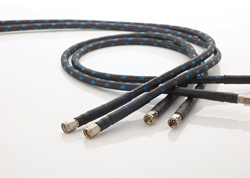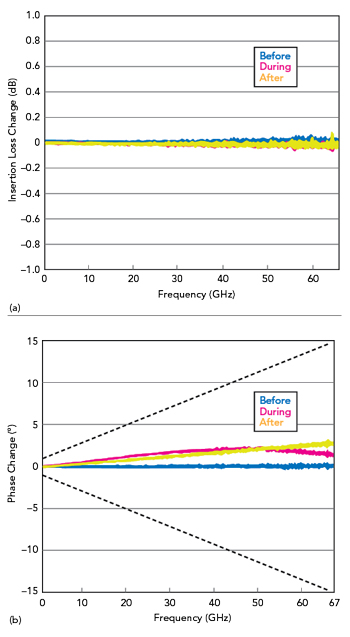
Today’s 5G business model aims to provide mobile and fixed internet access at broadband speeds about 100x faster than possible with current technologies. The business drivers behind this include the need to transport significantly larger volumes of data more quickly; reducing latency across the network for applications that include the IoT, real-time manufacturing and process control; and the general need to increase the number of devices on the network, for innovations including connected and autonomous vehicles.
This upgrade to a 5G network brings a range of challenges, as the technical approach to attain higher data rates and lower latency is more complex than previous generations of mobile infrastructure. At mmWave frequencies, the interconnects become very small, making connector design complicated. “Phase performance that endures” is a performance benchmark that cabling and interconnects must achieve, especially in the test & measurement environment. The amount of bending and stress the cabling sees is significant, reflecting an environment that requires phase stable cables.
For 5G to work, much higher frequency bands with greater bandwidth are a must, and the cabling and interconnects become critical components of the system’s performance. This is why it is important to use cabling and interconnects designed and built for a 5G world. After all, if the cabling is first to let the engineer down, it remains the most system critical element, in terms of reliability.
MWX161 Interconnect
To withstand the rigors of operating at this level of system performance, Junkosha has developed a new generation of cables operating well into mmWave frequencies and designed for high temperature and extreme flexure environments. The MWX161 has a frequency range to 67 GHz and a slim, low profile design with a maximum thickness of 7.9 mm, smaller than a HEX coupling nut. The small diameter of the interconnect was designed for easy connection to a 16- to 24-port vector network analyzer (VNA). To aid such dense connections, a torque driver is available to mount the interconnect onto a face with multiple connectors arranged in a narrow pitch. In addition to multi-port VNAs, typical uses for the MWX161 include narrow pitch RF matrix switchers, which route RF signals among multiple inputs and outputs, and multiple connector device under test (DUT) boards, which serve as an interface between the automatic test equipment and the DUT.

Figure 1 Typical insertion loss and |S11| of a 1 m cable assembly with two 1.85 mm connectors.

Figure 2 Change in insertion loss (a) and phase (b) with static bending, using a 30 mm bend radius.
The MWX161 achieves low insertion loss and return loss across the full 67 GHz band (see Figure 1), as well as excellent insertion loss and phase stability with bending (see Figure 2). The MWX161 is rated for operation from −65°C to +125°C, and the phase change from −65°C to +85°C is typically within ± 40 degrees.
The interconnect has a low dielectric constant due to Junkosha’s precision expanded PTFE tape wrapping technology, key to achieving a low dielectric constant, high flexure and phase stability with both flexure and temperature deviation. Junkosha’s legacy fluoropolymer expertise and precision engineering enable this unique expanded PTFE tape wrapping capability. This process, uniquely implemented by only two manufacturers in this sector, allows Junkosha to deliver a flexible cabling assembly achieving “phase performance that endures” at mmWave frequencies.
The MWX161 interconnect solution is available with four connector options: 1.85 mm with performance to 67 GHz; 2.4 mm with performance to 50 GHz; 2.92 mm to 40 GHz; and 3.5 mm to 26.5 GHz. Custom cable assembly lengths are available.
During the last 10 years, applications for mmWave cabling and interconnects have increased, moving from the military and space sectors to commercial markets, including security and smart cities. Airports are deploying high performance body scanners, using advanced multi-port arrays. Emerging volume markets are automotive communications and radar, growing as smart sensors and wider smart infrastructure are being deployed. Junkosha developed the MWX161 to support 5G and communications applications through 67 GHz and will continue to advance its interconnect technology to serve even higher frequency applications.
Junkosha USA Inc.
Irvine, Calif.
https://www.junkosha-mwx.com
